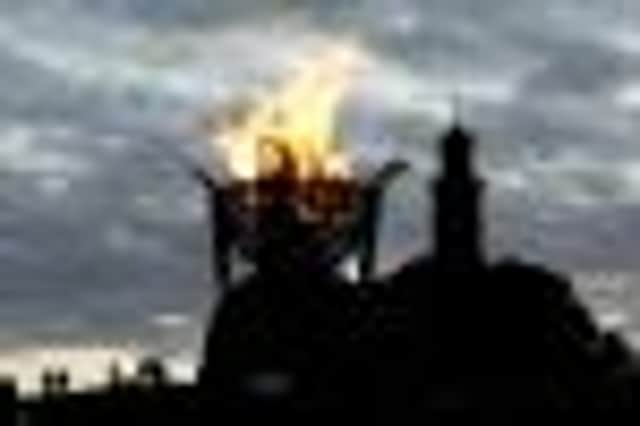Diamond Jubilee 2012: Worldwide they tripped light fantastic for Queen


In what promised to be one of the most visually striking celebrations of the Queen’s Diamond Jubilee, thousands of beacons were due to be set alight the world over yesterday, as communities touched by the monarch’s six decade-long reign paid tribute with an ancient British custom.
Long used to rejoice at times of Royal Weddings, Jubilees, and Coronations, the beacon chain allowed the Queen’s admirers to bridge countries and continents to form one, flickering display of affection.
Advertisement
Hide AdAdvertisement
Hide AdSpanning the length and breadth of these shores, along with a host of nations from the Commonwealth, more than 4,200 beacons were due to be set alight over the course of the day, including nearly 200 in Scotland.
After events such as the Thames Diamond Jubilee Pageant allowed Britons to commemorate the Queen’s service, it was an occasion which demonstrated the international reach of the monarchy.
The chain began in the New Zealand town of Blenheim where around 60 people gathered before dawn to light their beacon and sing God Save the Queen.
In Australia, the honours were carried out in Canberra by prime minister Julia Gillard, while a cluster of Scouts and Guides in Tonga took pride of place at a ceremony to continue the chain of light on its way west across the globe.
Outside Parliament House in Canberra, Ms Gillard put aside her republican sympathies to pay respect to the Queen.
Addressing a sizeable crowd, she said: “Tonight we are reflecting not just the past, on the passing of six decades. We are reflecting on a life well lived, a life of sacrifice, a life of service.”
In Kenya, an emotional link with the Queen’s ascent to the throne was made when a beacon was lit at the Treetops Hotel in the Aberdare national park.
It was there, in 1952, where the Duke of Edinburgh told the then Princess Elizabeth that her father, George VI, had died, and she was now monarch.
Advertisement
Hide AdAdvertisement
Hide AdThe chain of the fire was to include Tristan da Cunha, a remote volcanic group of islands in the south Atlantic, Jamaica, Malta, the Falkland Islands, Uganda, and Islamabad among others.
As night in Britain began to fall, the hundreds of torches across Britain were set to be sparked between 10pm and 10:30pm.
Throughout Scotland’s communities and coasts, the torches were due to go up, 192 in all, spanning the country’s most remote community – Fair Isle, perched between Shetland and Orkney – to urban settings in Glasgow, Edinburgh, and Aberdeen. Places special to the royals – such as Balmoral, and the Palace of Holyroodhouse – were also set to see beacons set alight. The most northerly was situated on Saxavord Hill on Unst.
In East Lomond Hill – an extinct volcano in the former royal burgh of Falkland in Fife which was a favoured hunting ground of the Stuart Kings and Queens – guests were also due to be treated to a series of fire sculptures.
Stuart Haszeldine, a geology expert who attended the event, said: “The extinct volcanoes of Fife form part of a continuity of connection through time and place across eastern Scotland. The long-gone eruptions of their fiery past can only be imagined, but become briefly more real through visible beacons on the hilltops communicating this celebration of royal longevity, continuity and connection.”
Atop Ben Nevis, a team from the Help for Heroes armed forces charity were poised to light their beacon last night, the culmination of arduous, but rewarding ascent. The 52-strong team, comprising of injured service personnel, 14 people from the Personnel Recovery Centre in Edinburgh, and volunteers from RAF Kinloss Mountain Rescue, set off from Fort William at 5pm, and arrived were set to arrive at the summit at 10.30pm.
The climb saw six RAF volunteers carry gas cannisters and the beacon up the mountain, and all those who took part said the occasion would live long in their memory.
Speaking before the ascent, Dianne McLeish, the local Help for Heroes county co-ordinator, said: “Whilst I am looking forward to climbing with the team, I am a bit apprehensive as there is still snow on ‘The Ben’ at the moment, but it will be a great challenge – a once in a lifetime opportunity.”
Advertisement
Hide AdAdvertisement
Hide AdFurther south, 60 beacons were due to be set alight along Hadrian’s Wall, each marking a year of the Queen’s reign, and in London, beacons were to spark into life at some of the capital’s most historic locations, including along the battlements of the Tower of London and on the parapet of Windsor Castle.
The chain was due to be completed by the Queen herself when she was to place a diamond-shaped piece of crystal into a pod, triggering the lighting of a final, vast beacon situated at the mouth of the Mall.
Bruno Peek, pageantmaster of the Queen’s Diamond Jubilee beacons, said: “We set out to have 2,012 beacons, which would have been the most ever for this type of occasion. To have reached double that figure reflects the national and worldwide respect and affection for the Queen and the desire to celebrate her 60-year reign.”